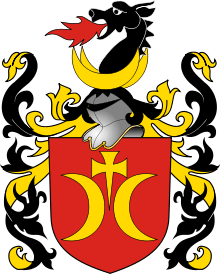Heraldic clan


A heraldic clan (ród herbowy), in Poland, comprised all the noble (szlachta) bearers of the same coat-of-arms. The members of a heraldic clan were not necessarily linked by consanguinity. The concept of heraldic clan was unique to Polish heraldry.
History
The Polish word "herb" derives from the German "Erbe", "inheritance" or "heritage",[1] and denotes a coat of arms or family crest. Unrelated families could be inducted into the same crest and thus become co-armorials sharing the same "herb". Bearers of the same coat-of-arms were variously called "herbowni", "współherbowni" (co-armorials), or "klejnotni", from "klejnot", "jewel". The numbers of such individual families often reached several dozen; several hundred were not uncommon.[2][3]
The heraldic-family tradition constitutes one of the hypotheses about the origins of the Polish nobility: the unique feature of Polish heraldry being the practice of inducting unrelated families into the same coat-of-arms, sometimes with minor variations of tincture. In time, all those families were integrated into the Polish nobility, the szlachta.[4] The number of families within a particular "heraldic family" varied over time and could be affected by heraldic adoption. Entire noble classes from other nations, for example from Lithuania, were incorporated by adoption—granted an indygenat—into the Polish nobility and its heraldic system. Removal from the heraldic system was also possible, by vituperatio nobilitatis, a legal procedure for revocation of nobility.[5]
Polish nobility, the szlachta, originated in the Middle Ages from chivalric heraldic clans which provided military support or resources to king, duke, or overlord. Over the centuries, membership in the nobility was extended to those who served their localities or towns as deputies or senators at sejmiks or sejms or as judges and other civic officials. Members of the nobility could be further rewarded with honorary functions at the royal court.
Polish family crests have their individual names, usually stemming from the heraldic clan's ancient seat or battle cry; or from the way the arms were depicted "canting arms". The battle-cry derivation of many Polish heraldic family names has given rise to the now outdated term "proclamatio arms", referring to the names' hortatory nature.
From the 17th to the 20th centuries, belonging to a distinguished house and a shared armorial lineage mattered to members of the szlachta. That is why most modern Polish armorials are arranged by clan names, rather than by their respective family crests, as was the case with 16th-century armorials.[6]
Noble titles were absent in Poland
After the Partitions of Poland in the late 18th c., adherance to a herb, family crest, became more ceremonial and symbolic than real. This was due to the nobility generally becoming greatly impoverished and inactive in power structures in the 19th c. The few exceptions were among members of some grand Polish magnate families who were able to achieve influence with the occupying powers, or with Napoleon and his successors or with the Pope and received such foreign titles as "Prince", "Count", or "Baron" while keeping their original Polish herb. Possibly more than the Scottish clan model, the German Wappengemeinschaft, "armorial association" is closer to the Polish concept of the "herb". Thus the Polish szlachta and its heraldic system may be considered more akin to the Germanic sippia or even the Scandinavian ætt.
See also
References
- ↑ Słownik wyrazów obcych [Dictionary of Foreign Expressions], Warsaw, Państwowe Wydawnictwo Naukowe, 1971, p. 274.
- ↑ Maurycy Orgelbrand - (praca zbiorowa): Słownik Języka Polskiego. Wilno 1861: Wydawnictwa Artystyczne I Filmowe - /reprint/ - Warszawa, 1986, s. 398.
- ↑ "Tworzenie się polskich rodów heraldycznych" ("Creation of Polish Heraldic Families"), Pro Fide, Lege et Rege no. 1 (48) /2004 (retrieved February 22, 1013)
- ↑ Maurycy Orgelbrand - (praca zbiorowa): Słownik Języka Polskiego (A Dictionary of the Polish Language), Wilno, 1861: reprint, Warsaw, Wydawnictwa Artystyczne i Filmowe, 1986, p. 398.
- ↑ http://www.instytut-genealogii.com.pl/index.php?mod=artykuly&id=2&itemid=92 "Tworzenie się polskich rodów heraldycznych" - "Creation of Polish Heraldic Families", Pro Fide, Lege et Rege no. 1 (48) /2004 [retrieved February 22, 2013]
- ↑ Paprocki - http://literat.ug.edu.pl/grafika/herby.htm
